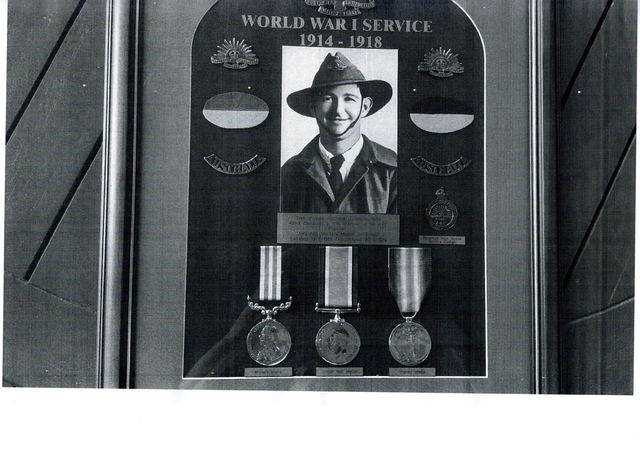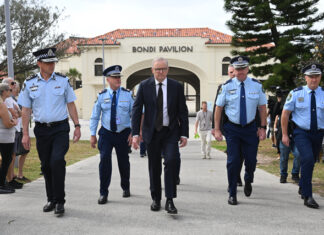While researching the Anzacs of the Southern Downs who fought in the Great War of 1914–18, there appears to be quite a few men from the ranks who were awarded the Military Medal for bravery in the trench wars of France and beyond. One of these brave men stood out in the battles that involved the allies push towards the Hindenburg Line and that was Private Richard Gillespie, a young farmer from Swan Creek who participated in the largest battles at that time. He had only just turned 21 years of age when he answered the call to service, and this is his story.
Richard Gillespie was born in 1894 at Warwick and lived and worked on the family farm at “Fairview”, near Swan Creek about 10 kilometers from the township of Warwick.
He was the son of Armstrong and Mary Gillespie and attended the small school of Swan Creek for his early education, until the nation called on the young men of the country to enlist in the army to help defend the Empire against Germany.
Richard went to the recruiting office in Warwick on 19 February 1916 and was immediately inducted into the infantry with the 41st Battalion, “C” Company 11th Division that was raised in Brisbane. Here, Richard completed initial training, before deployment to England for further training.
He embarked for England from Sydney on board the HT “Borda” on 5 June 1916 and was sent to England with the 42nd battalion from Southhampton, on 25 November 1916, just in time to join the allied advance towards the Somme to help stop the German advance in the spring offensive of 1917.
Richard was proving to be a brave and resourceful soldier despite a couple of indiscretions with authority at Armentieres for being late for parade and absent without leave (AWL) and was hospitalized on 2h September 1917 at the 1st London General Hospital at Weymouth suffering from appendicitis. Once recovered and back with his battalion Richard was involved in many of the major battles with the Anzacs which included Broodseinde, Ypres, Passchendale and the bloody conflict at St. Quentin in September/October 1917, when they breeched the Hindenburg line. He suffered from German gas attacks and trench feet (a painful condition caused by living in the trenches up to the knees in water as they sheltered from the incessant artillery shelling from the Germans).
Richard was unaware that his finest hour with the battalion was when it was promulgated in the London Gazette that he had been awarded the Military Medal for bravery on 24 June 1917; however, he was already on the way back to Australia via HMAT “Nestor” on 20 May 1919, after his discharge from the 1st General Hospital at Camberwell having suffered further problems with appendicitis.
In a registered letter posted to his mother on 10 July 1919 here is how the news was received: “I have much pleasure in forwarding per separate registered post, the Military Medal which was awarded to you while serving with the Australian Imperial Force. This medal has only just been received from AIF Headquarters, London, with the request that it be transmitted to your mother – Mrs. M. Gillespie of “Fairview”, Swan Creek, Killarney line Queensland, but as you arrived in Australia before the decoration, I am sending it direct to you and trust you may be spared to wear it for many years to come.”
Private Richard Gillespie was part of the Anzac legend and will go down in Australian history as one of those thousands of intrepid young men who answered the call to arms. He was one of the few who received the Military Medal for bravery under fire. He was acknowledged for his service and award in the Warwick Examiner and Times on 8 September 1917, when it said:
“Richard Gillespie, son of Mr. and Mrs. A. Gillespie, Mt. Stuart, has been awarded the Military Medal for meritorious service in France. His many friends will feel proud of the distinction that the young man has won”.
Once back in Australia, Richard received a great welcome home but for the rest of his life he would carry the physical (loss of hearing) and psychological scars of battle like many Anzacs who went through the horrible experiences of trench warfare on the Western Front.
Richard struck tragedy again when he met and married Florence Smith, who passed away giving birth to their first child.
It was not until 1931 that Richard at last found love and in 1931, married Alice Briggs of Maryvale at St. Andrews Church in Warwick and returned to “Fairview” where they raised six children. Tragedy again struck Alice and Robert when their 16-year-old son Robert passed away after a drowning accident and his young sister Jean also passed away at the tender age of four.
Richard continued to work on the family farm despite suffering health issues from his wartime gassing and other injuries. He led a great life until his passing on 23 November 1963 aged 69 years and now lies at rest in the Swan Creek cemetery.
Alice, his devoted wife, joined Richard in 2000 and is interred at Eden Gardens in Warwick.
Richard Gillespie was a brave and humble man who, apart from surviving the Great War and coming back home where 60, 000 young Anzacs did not, and now lie in foreign soil. They will never see home again. It is a legacy that all Australians must never forget and always must honour such men as Richard Gillespie, MM.






